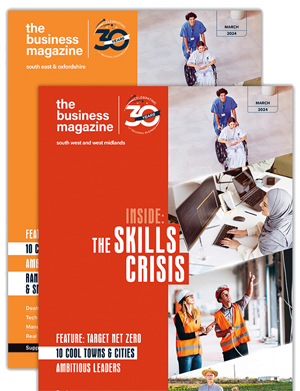Commercial Property - Do we need workplaces... or simply spaces to work?


SEGRO and The Business Magazine gathered Thames Valley sector experts to discuss current market conditions and matters affecting its future wellbeing. Factors such as technological advances, workstyle change, new regulation, and energy efficiency came under debate but there was one underlying question . . . do we need workplaces... or simply spaces to work?
Market overview: Grade A, green thinking and pre-lets
David Murray invited Roundtable comment on only 28% of the 12 million sq ft of available Thames Valley office space being Grade A, with 50m sq ft of leases due in the next five years.
Chris Richmond of PwC: “We have 18 lease expiries coming up within five years so we are active in the market, but we have precise requirements for larger floorplates and it is very clear that such Grade A space is lacking in the Thames Valley. We are also looking for fuel-efficient buildings that will sell our business. We have occupied many of our buildings for 20-25 years, and now we want to send out a statement through our real estate that we are a modern forward-thinking business.
“Because we have lease expiries coming up shortly in Reading, we are having to consider contingencies. I see ourselves having to work with our landlords to extend our occupation in many of the buildings we have got, while keeping our future plans in place to secure buildings that support our business.”
Property agent Jeremy Bates of Savills: “That’s exactly what we are seeing with many global corporates in the Thames Valley. Tenants have stayed in buildings, but increasingly some of those buildings are becoming obsolete. Nowadays, there is increasing acceptance that a better workplace produces a better business, which 10-15 years ago was less prevalent as an ideology. Due to more active leasing markets and take-up levels in the late 1980s and 90s informs us that there is a significant opportunity for new development over the next few years as companies with lease events are likely to decide to relocate due to both inappropriate or ageing buildings and the desire to provide a better working environment for their people.”
Chris Hiatt, of Jones Lang LaSalle mentioned another potential change to the office market. “There has always been a ready supply of speculatively built buildings, but that supply has now dried up. There are eight buildings in the western corridor being spec built at the moment – we can’t see another wave of spec building coming through. We may see a move to the world of pre-lets following the American and Australian model of ‘built to suit’.
“Also, watch out what happens to the costs of these buildings because the rents we are seeing on built space at the moment are the product of poor demand, but if you start putting a proper viability on these schemes it will be a totally different rent.
Bates suggested there are currently two active poles of the office leasing market: the Grade A market where corporates seek to gain cultural change, consolidation and operating cost savings; and the value market where companies were taking on “existing ‘on the shelf’ buildings and doing something interesting with them inside.”
Murray asked Kate Dean about the type of development planned on SEGRO's major IQ Slough project: “There is not going to be any spec building for the time being. Our ethos is that we are ‘getting ready’, preparing by doing demolition and enabling works but we won’t commit to spec building yet. That’s a comfortable approach for us because it foreshortens the delivery timescale, while giving us flexibility around design when occupiers come to talk to us about pre-lets.”
Commercial real estate agent Simon Peacock wondered if occupiers were approaching developers early enough to discuss pre-lets. Dean said SEGRO’s current demolition and enabling work would assist occupiers to schedule their requirements better.

Where is demand coming from?
Dean said there was still a cross section of space requirement in the Thames Valley, from large corporates (Aker Solutions had taken 270,000 sq ft, Huawei – 140,000 sq ft) to SMEs needing just 2-3,000 sq ft. “Lease events are driving some demand but there’s also growing corporate M&A activity, and many companies operating out of split sites.
“Occupiers know they can achieve lots of running cost and workplace efficiencies by getting everybody under a single roof. We’ve had a number of such requirements, which are driven by both cost savings and operational efficiencies.”
Chris Early explained that Telefonica had changed rapidly – “acquiring parcels of new very flexible space to accommodate various project teams.” Consolidation of core space had brought cost advantages through single building management and reduced staff travel between sites, but also an improved campus-style work environment.
Ian Durbin agreed that running costs were a driver of change in the market. “The shackles are on expenditure, which will only favour more mobile working.”
Early said there was demand among small growing companies, particularly for fundamentally different working environments that supported flexibility and workstyle change. Some owners were keeping properties empty because they were holding out for market pick-up or a traditional letting arrangement – which they were not going to get.
“Coming into the commercial property market I found it rather ossified, with a lot of archaic practices and quite rigid offerings. As a tenant I feel the market has a long way to go in providing proper flexibility and variety to support a growing UK economy.”
Is flexible hub-working the future?
John Alker: “As a green NGO we recently asked: ‘In a future where resources are more constrained, where are the business opportunities?’ We did some horizon scanning, and trends such as advances in IT and changes in working patterns (more people working flexibly from home, part-time or with two jobs) came through very strongly. So flexibility is absolutely essential for future office requirements. We are seeing that in a niche way now with landlords beginning to be more flexible but I think we are going to see that on a massive scale. With cloud computing and better security of data, companies, even competitors, may share space in buildings and share the economic advantages of this type of ‘hub-working’ environment.”
Early: “It’s about needs and working culture. Things won’t change overnight, or across the board. Each company will have different requirements. There is a big cultural resistance to changing patterns of work, often inertia, and it requires a different form of management. Some line managers struggle to manage people they can’t see.”
Hiatt: “I like the club model with an office of meeting places where people can interchange views – an environment of creativeness and innovation that drives businesses.”
Alker suggested that people working from home could go ‘stir crazy’ and this could provide opportunities for service provision. “I think we will see more suburban-hub working, where people use local centres for a change of scene, interaction with other workers and a decent cup of coffee.”
The average commute to London took 58 minutes per day – four years over a working life, Alker revealed.
“The key word is ‘average’. Many people have longer commutes and when the infrastructure goes wrong ….that’s where the frustration and burn-out comes in. How do we provide a suitable working environment that avoids that?”
Murray pointed out that technology, such as smartphones and laptops, allows for commuting time to be used productively.
Early: “People are re-assessing the way they work. I did. I used to spend hours commuting to London every day. Some days were valuable but on others I churned through work that I could have done elsewhere or at home. The only benefits were meetings and interaction with people, but I didn’t need to be seeing the same people in that same vanilla environment five days a week.”
A lot of people still like vanilla
Consulting engineer Durbin: “I guess I am part of this fringe; this mobile flexible working environment – I work across two offices and home, and all I need is a docking station and somewhere to make tea. But, maybe 90% of what we do is still the standard vanilla – and it will get better, and better, not just from the compliance point of view with regulatory bodies, but because occupiers are focusing on work environment and energy costs and we will have to react to that.”
Architectural designer Yvette Hanson agreed that the workplace is changing but said there would still be a need for ‘traditional office requirements’. “Talk tends to focus on the mobile workforce, new ways of working and the trend for management to focus on output rather than the hours spent at a desk; about technology and empowering people to work where and how they want, which really suits some businesses but I don’t see offices disappearing. There still needs to be a hub and there are still many businesses such as the financial institutions and the legal firms who would still struggle to perform their day-to-day job sitting in a coffee shop with a laptop."
Hanson agreed with Peacock however, that the internal design and functionality of office areas has and will continue to be more varied and flexible.
Bates: “Flexible working has always been a driver of demand in the market albeit a relatively small one when compared to large corporate located across the Thames Valley who are still acquiring large-scale HQ offices, to accommodate big, largely office-based workforces. Current examples would include Aker Solutions acquiring over 200,000 sq ft at Chiswick, in West London with IMG and Huawei being under offer on 110,000 and 140,000 sq ft at Heathrw and Reading respectively.”

Location, location, location…
Alker pointed out that while flexible out-of-town working may be a trend for the future, cities continue to be a popular focus, particularly London.
Hiatt: “For our occupiers it is all about demographics… where am I going to get my workforce, with the right skills, at the right price, and can I get that supplied close to my customers?”
Dean said Slough’s location was a key factor in its continuing success. Access to Heathrow and London was highly important, as was access to an appropriately skilled workforce. Locational benefits had also helped generate clustering of like-minded industries such as pharmaceuticals and automotive, with clustering bringing its own collaborative and business benefits. “Of course, if you can provide the right sort of properties, then it makes moving so much easier for such companies.”
Bates and Peacock stressed the need for the property sector to identify such clustering or demographic trends, and to provide the product required for this next generation of customers.
As occupational densities rise . . .
Bates felt the pace of workstyle change would actually become noticeable in the way space is used – less fixed desk-space, more collaborative creative areas, etc – within existing buildings, many of which would be refurbished and adapted to suit the tenants.
Dean said different ways of working, such as hot-desking were becoming more common. However, the major change was in occupational densities. “Historically we used to assume an occupational density of 1-10 sq m, that’s down to 1-6 sq m or 1-7 sq m for some occupiers. Space is perceived as relatively expensive so it needs to be used more efficiently, but then that affects building services. The building has to be designed to cope with those levels of occupational densities.
Richmond said PwC had already dramatically changed its use of workspace at its new More London site, the first major office in the UK to be awarded the BREEAM ‘Outstanding’ rating. This change had been led by comprehensive occupancy data gathered over many years. “Often the number of people coming into offices was half the number of desks we had.”
PwC had now cut its office working space requirements by roughly one third. “That change is driven very much by our staff. Their average age is 29 and they don’t want fixed desks, they want to work where they are, on the train or from home. When they come into the office they want a selection of space – it might be a desk, or a refreshment hub with soft chairs, or a booth for a private meeting. We provide all that. It is a tremendous lift to the spirits of our people that they can select an environment that suits them at that time to do their task.”
And it works. Richmond revealed that More London occupancy rate efficiency is 85%, and the reduction in fixed desks was saving £12 million per year. More London has 4,000 desks for 5,500 people, 80 sq ft person/100 sq ft per desk, and only partners have ‘offices’, which double up as meeting rooms.
“The thrust of More London is actually about the health and wellbeing of the people who work there,” added Richmond.
Early noted the increasing use of outsourcing by many organisations. Corporate headcounts might be lower on paper, but the combined staff and suppliers using a building placed demands on flexibility and the building itself. “How many external people you should have in your buildings at anyone time is always an interesting debate.”
Carl Blanchard stressed control of this external-internal ratio was important for buildings to work efficiently. “A push towards non-fixed headcount – people employed as and when you need them – will have a massive impact on the potential size of buildings you need and their flexibility.”
Murray added that making workplaces into attractive environments might actually promote more usage by external suppliers – a ‘these offices are better than our own’ syndrome.
Blanchard felt that an office space should be “something smaller, higher quality and used for a purpose – it’s a resource not just a destination. At the moment our offices are destinations, with thousands of people meeting at the same place at the same time, which is why we have commuting problems. If we turn that on its head, then office space can become something else.”
Hanson spoke about the new style of office interiors, enabled by telecoms and IT advances. The ability to create flexible desking systems and a variety of workpoints, has enabled occupiers to spend less time wondering if they have estimated their expansion targets correctly. As the design of the working environment includes a variety of work settings and flexible spaces, interestingly the number of people we can fit within a building is becoming more limited through the base build design of the staircases and the M&E installation rather than the space for desks.
We are now working with a lot of occupiers at the outset to influence the base build design to ensure these factors don’t limit the future workplace opportunities.
Big floorplates are phenomenal; but start a relationship
Blanchard: “For me the key driver for new ways of working is space utilisation. People take 200,000 sq ft and six months down the line it’s only 60% used. My question is: Do corporates still really need these big open floorplates?”
Richmond said PwC in Glasgow moved from four floors onto a single floorplate of 20,000 sq ft. “We created neighbourhoods for team working, with a central refreshment park and the difference in the ways that people work has been absolutely phenomenal. It draws people together, they can walk the floor, see and meet. That’s a very powerful environment. Over different floors, some teams won’t even know each other exist in the same building.”
Blanchard: “But, how do you adapt your organisation and the way its people work to allow for the fact that that type of building doesn’t exist everywhere? It’s clearly not sustainable to knock down everything and build sheds, so how do you consistently create that sort of environment?
Richmond said PwC managed it by engaging with developers at an early stage. “I don’t think we are unique; we are one of many occupiers who want to change the product. Why would we want to move, unless it was into accommodation that genuinely supported the needs of the business? That’s where we are at with developers. Now, when we talk about big floorplates and explain why, developers embrace it more and more. It’s about starting to create partner relationships that weren’t there before.
“And it goes on from that to sustainability. The younger our staff, the more we are being pushed on sustainability. So, from the real estate point of view we are very much fundamental to the growth of the business.”
Will refurbs be the new development?
Peacock highlighted the huge challenge that shorter leases presented to the refurbishment market. “We have a huge tired stock out there coming out of 20-year into 5-year leases, so refresh points will become more frequent, and landlord-tenant relationships much closer.”
Hiatt: “Will refurbishment become the new development? Will we see less knocking down and an increase in making something of the existing structure? Previously, occupiers have moved out while things were upgraded, then moved back in again, but that may not be possible. How do you keep a business going when you are having half of it refurbished? There will need to be more landlord-occupier partnership discussions for sure.”
In re-leasing negotiations, more and more tenants were asking landlords if they could improve the energy efficiency of a building, Richmond added.
Fit-out costs would also have to be addressed said Peacock. Normally they would be amortised over the course of a long lease, but with five-year leases more in favour such costs would not be covered so simply. Another problem is that we are designing buildings that are too rigid, not modular enough and can’t be adapted easily.”
Dean: “We have buildings in our portfolio that we are choosing to refurbish rather than demolish and put up new buildings. That’s primarily because the fundamentals of these 20-25 year-old buildings are what architects, under the new building regulations, are now being asked to design. It’s almost come full circle; their design is back in fashion.”
Bates mentioned market viability: “If you end up with buildings where the ratio of lettable space to non-lettable space changes, then it is simply a matter of economics, that unless the costs come down, then rents will have to go up. Viability and sustainability have been the two big factors in play for institutional investors and developers over the past decade and I’m sure they will remain so for the next decade. That’s why debt and investors appetite for speculative development has wained in the market today.”
Hiatt said saleability had to be carefully considered: “Have we got to the point where people are saying, ‘Actually £22-£25 per sq ft is all we are going to pay’?
Who’s going to pay to go green?
Murray queried whether occupiers were actually prepared to pay more for environmentally friendly green buildings.
Better awareness of such buildings performance would help occupiers make that decision, Alker suggested: “I’m always very careful not to overstate the case for a ‘green premium’, it’s probably more sensible to talk about a ‘brown discount’. But undoubtedly the legislation that will potentially make it illegal to let F and G rated buildings (by Energy Performance Certificate) from 2018 is going to focus minds. However, the Government needs to get its act together and clarify how this legislation will work in practice. I think it could be incredibly significant, but fear it could be full of loopholes.”
Blanchard thought that, like financial tax loop holes, people would look for ways to ‘green-wash’ buildings to avoid the implications of such legislation.
The difference between a building’s potential and actual performance was often misunderstood, said Peacock. Occupiers needed to be educated in the use of ‘green’ buildings.
Monitoring and measuring building-performance was still a challenge. PwC’s More London building was an example that ably proved its ‘green’ rating, but too many probably did not.
Durbin suggested “the people who know the building best (developers, designers, M&E contractors) should get together and continue the journey of managing its performance.”
An MOT for buildings?
Hiatt: “There is a need for an appropriate rating system because the ones we have now don’t really do the job. The annual review Green Flag system used in Australia would be far better. It would promote the introduction of ‘green leases” which put an onus on both landlords and occupiers to retain the rating.”
Alker: “We simply don’t know how most commercial buildings are performing – there is a huge information deficit. When you buy a car, you know what its fuel consumption is going to be, and you get a yearly MOT to make sure it’s roadworthy – what’s the equivalent for buildings? The proposed Energy Efficiency Directive could require energy audits and give the Government an opportunity to extend Display Energy Certificates to all buildings, he suggested.
Richmond admitted that sustainability is very much part of PwC business philosophy and as sole occupiers, ‘green’ gains were tangible – tri-generation had contributed 47% against a predicted 25% – but it would be far more difficult to establish and control performance in a multi-occupancy building.
Peacock noted that many businesses were still not engaged in the ‘green’ journey. “BREEAM started to raise awareness of building standards, but most people don’t realise that building regulations have been ratcheted upwards hugely and go up again next year, so you can’t actually build something that’s not BREEAM good nowadays. EPCs are potentially a stick coming in to push people into recognition of building performance ratings.”
Dean: “EPCs and BREEAM are what occupiers focus on, but from the developers’ point of view it is meeting the new building regulations regime that is driving costs. That’s why we are currently seeing rents of £30 per sq ft, because you can’t afford to build them for anything less than that.”
Does BREEAM promote a true ‘green dream’?
Hanson: For me the BREEAM assessment to date hasn’t really reflected what makes a truly green building as significant points are awarded for things you have no control over, such as location. BREEAM has been promoted as the green indicator so consequently it is what occupiers have focused on rather than the building’s energy performance or its true sustainable criteria however, it’s good to see that the 2011 revisions are going some way to bridging his gap.
Peacock: “All I am hearing from occupiers is energy efficiency, not sustainability.”
Dean: “If occupiers talk to us about pre-lets, then sustainability, BREEAM, EPCs are very much in the conversation, but with standing stock I have never had anybody say they’re not taking the space because it does not meet a specific rating. There’s an acceptance that the ratings are there, but no challenge or interest to demand them.”
Hiatt: “It’s back to the basics of location. You can’t lift a building. It is where it is.”
Peacock suggested ratings would only come into the decision-making process for many occupiers when comparing two similar buildings in the similar locations.
Bates said BREEAM is less valuable as a qualitative benchmark, for buildings when occupied and in use and needs to continue to evolve or be superseded.
Durbin thought occupiers needed more education about BREEAM ratings – which are attractive from a marketing point of view, but may not provide what occupiers actually want.
PwC’s Richmond agreed with more education, but considered BREEAM a useful framework. “It sets people down the road to understanding what their different impacts can be to a building’s environment.” He also admitted that More London’s BREEAM Outstanding classification had been “a tremendous advert, and good for our business.” PwC had staged 3,000 More London tours over the past year. Perhaps businesses should also look at their buildings in terms of brand enhancement. “It’s not all about costs, it’s about a business doing the right thing.”
Bates: “It is great to hear that occupiers like Telefonica and PwC have a property strategy driven by the needs of the business, but I would be curious to know at what point financial considerations constrain their ability to fully implement this.”
Early agreed that buildings needed to fit into a wider business context, but suggested that individual companies had to determine their own sustainability objectives as a balance of green ethics and cost-effectiveness.
‘Labourtainment’ and guilt-free golf
Murray queried if ‘leafy-view’ surroundings to buildings were now becoming more important.
Dean said nearby greenery was important, but more relevant was the ease with which staff could access amenities such as shopping, lunchtime leisure, and travel options for getting to work. “Occupiers are looking for the whole basket. It’s about providing a pleasant working environment inside and outside the building.”
Hiatt: “Green-space is not necessarily good. It’s about public realm and that can be hard or soft. You want to give something to people that excites them and motivates them. Employers want their people to be productive, so they have to provide them with ‘labourtainment’.”
Peacock: “I think cities have raised their game over the last 10 years. There has been in-town regeneration and maybe out-of-town has not yet done enough.”
Dean felt out-of-town property was “still on its journey”. Easy access, ample car-parking and big floorplates were not enough. It needs to offer more amenities in its business parks – leisure, shopping, hotels, bars. “It’s got to be a lifestyle experience. It’s not simply about getting to work, doing eight hours behind your desk and going home again.” Some older business parks would find that change very challenging.
Early: “Cities are more attractive now and that’s where the talent pool is, and wants to be. I do wonder if some outlying business parks will ever get filled.”
Hiatt: “The challenge to the cities is to provide housing that is affordable for its workers.”
Hiatt jestingly chided Early and the IT/telecoms industry for “giving us the wonderful ability to work anywhere anytime, but not giving individuals the confidence to feel guilt-free about playing half a round of midweek golf.”
Out-of-town small cities?
Murray asked the Roundtable to predict any other changes to commercial property requirements.
Bates pointed out that the Thames Valley was very much a first generation TMT region housing north American corporates, but now witnessing newcomers – “customers who need to be served” – from emerging nations.
Dean highlighted that the Chinese and Asian business cultures were unlike those in the West. “The Chinese don’t understand our hours of commuting. They like their housing to be close to their business, so they can walk or cycle to work.”
Murray wondered if ‘living above the shop’ housing might come to Thames Valley business parks. Bates felt it was very unlikely. “The emerging ‘live-work’ requirement is still very small and not one that I see influencing the mainstream Thames Valley office market.”
Dean felt increased mixed-use would be good. “It would provide more choice, and give more of a 24-hour culture to business parks and workplace environments which are often deserted after 7-8pm.”
Peacock: “So, out-of-town will become small city?”
Blanchard noted that Canary Wharf had done just that in recent years, introducing more residential, leisure, retail, and hotel options to the area. A good example of this kind of thinking is Willis who created its own ‘hotel’ in its City of London offices. “It’s used as overnight accommodation for internal business and has proved to be a great use of space.”
Dean said SEGRO’s IQ Slough business park would have two hotels, transport hubs, convenience shopping, restaurants, cafes and leisure facilities.
Messages to government
Suggesting the possible creation of a minister for commercial buildings, Alker said: “Commercial buildings don’t really have a home or a champion in government. That’s reflected in a lot of decisions coming out that are fragmented, confused or overlapping. We need clarity of the policy landscape. I think the industry would swap a degree of stretch for certainty. By all means be ambitious, but let’s be transparent, and informed: What are we expected to achieve, by when?”
Peacock added: “The planning system is under-resourced and confused. The market needs clarity.”
The SEGRO commercial property roundtable participants:
Kate Dean: Regional director, SEGRO
Chris Hiatt: Head of the national offices, Jones Lang LaSalle
John Alker: Director of policy & communications, UK Green Building Council
Simon Peacock: Jones Lang LaSalle, current chairman British Council for Offices, South West and Thames Valley region
Chris Early: Estates manager,Telefonica
Chris Richmond: PwC, sits on BCO Occupiers Group
Jeremy Bates: Executive director, head of National Offices, Savills
Carl Blanchard: Associate director, Jones Lang LaSalle
Yvette Hanson: Principal director, tp bennett, architectural & interior designers
Ian Durbin: Partner, Hoare Lea consulting engineers
David Murray: Managing editor and publisher of The Business Magazine, chaired the discussion












